Shamrock Rovers are enjoying a period of dominance in the League of Ireland Premier Division. The South Dublin-based club have won four league titles in a row since 2020 following an eight-year drought. Rovers secured the 2023 title in style, netting 67 goals in the process and finishing seven points ahead of second place Derry City.
Former Arsenal academy player Stephen Bradley has been in charge at Shamrock Rovers since 2016. He has overseen something of an overhaul and has been given plenty of time to implement his style of play. Bradley has brought stability and success back to Rovers with his possession-based play, earning plenty of plaudits along the way.
Moreover, the League of Ireland is becoming a well-known place for English clubs searching for incredibly talented youngsters. A prime example is Aidomo Emakhu, who came through the academy at Rovers, making his first team debut aged 17. After some impressive performances at Tallaght Stadium, the young forward was promptly snapped up by EFL Championship side Millwall.
In this tactical analysis, we will delve into Bradley’s tactics, looking specifically at the 2023 season and trying to ascertain why clubs still struggle to cope with Shamrock’s tactics after four years of dominance. To do this, we will analyse how the team performs in the game’s attacking, defensive and transition phases.
Preferred formations

The graphic above tells us that Bradley primarily uses a 3-4-2-1 formation at Shamrock Rovers. This formation boasts a defensive solidity that stems from the presence of three central defenders. The defensive trio create a robust backline capable of handling multiple attacking threats and covering a larger defensive area. The wide central defenders also play a crucial role in providing cover for teammates, tracking opposing wingers, and being given a licence to carry the ball out of defence.
This setup allows the team to dominate possession, dictate the tempo of the game, and smoothly transition between defensive and offensive phases. The wing-backs, positioned wider on the pitch, offer additional passing options and contribute to stretching the opposition’s midfield, providing a balanced approach to ball distribution.

The heatmap demonstrates where on the pitch Shamrock Rovers are most active. It’s no surprise that they like to stretch the pitch by using the wing-backs in the wide areas. Their forward movement stretches the opposition’s defensive line, creating gaps for Rovers’ central attacking players to exploit. Simultaneously, the wing-backs contribute defensively by tracking back, ensuring the team’s solidity when not in possession.

The formation’s effectiveness extends to defensive pressing and transition play. The front three, comprising the attacking midfielders and the lone striker, engage in high pressing when out of possession. This aggressive defensive approach aims to win back possession quickly, disrupting the opponent’s build-up play and potentially leading to turnovers in advanced positions.
The data viz shows us the Shamrock Rovers’ defensive territory. As we can see, they like to press relatively high up the pitch – this has been a critical element of Bradley’s tactics during his time at Tallaght. We can see that in 2023, Rovers held a higher line than in 2021, and their defensive actions took place higher up the pitch, indicating Bradley’s tactics are very much ingrained into the team’s style of play.
Utilising the wing-backs and creating overloads
When building an attack from the back, Bradley’s team will look to utilise the two wing-backs effectively. The primary principles of his style of play revolve around using off-the-ball movement to drag opponents out of position and allowing Rovers to create overloads. Rovers averaged 57.34% possession in the 2023 season, meaning they do look to dominate the ball and limit the opposition’s opportunities.
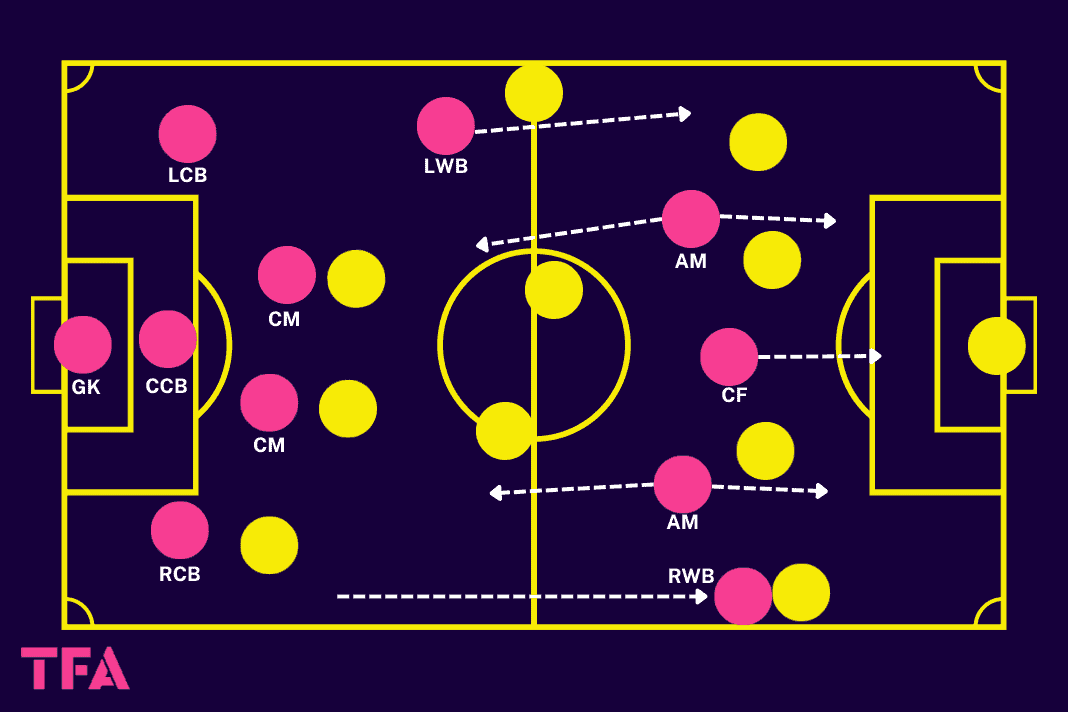
Typically, the right wing-back will push up to pin back the opposition fullback, while the right and left centre-backs will move into the space available in the half-spaces. The two central midfielders will drop back and often shield the central defenders, allowing them plenty of time and space on the ball. The attacking midfielders will either look to drop deeper or make runs in behind the opposition defensive line depending on whether Shamrock looks to build up through the thirds or utilise a long pass.
Meanwhile, the left wing-back’s starting position is often a little deeper than his counterpart on the opposite flank. Still, he will then look to push up higher, constantly creating a left-sided overload with one of the central and attacking midfielders during the build-up phase.
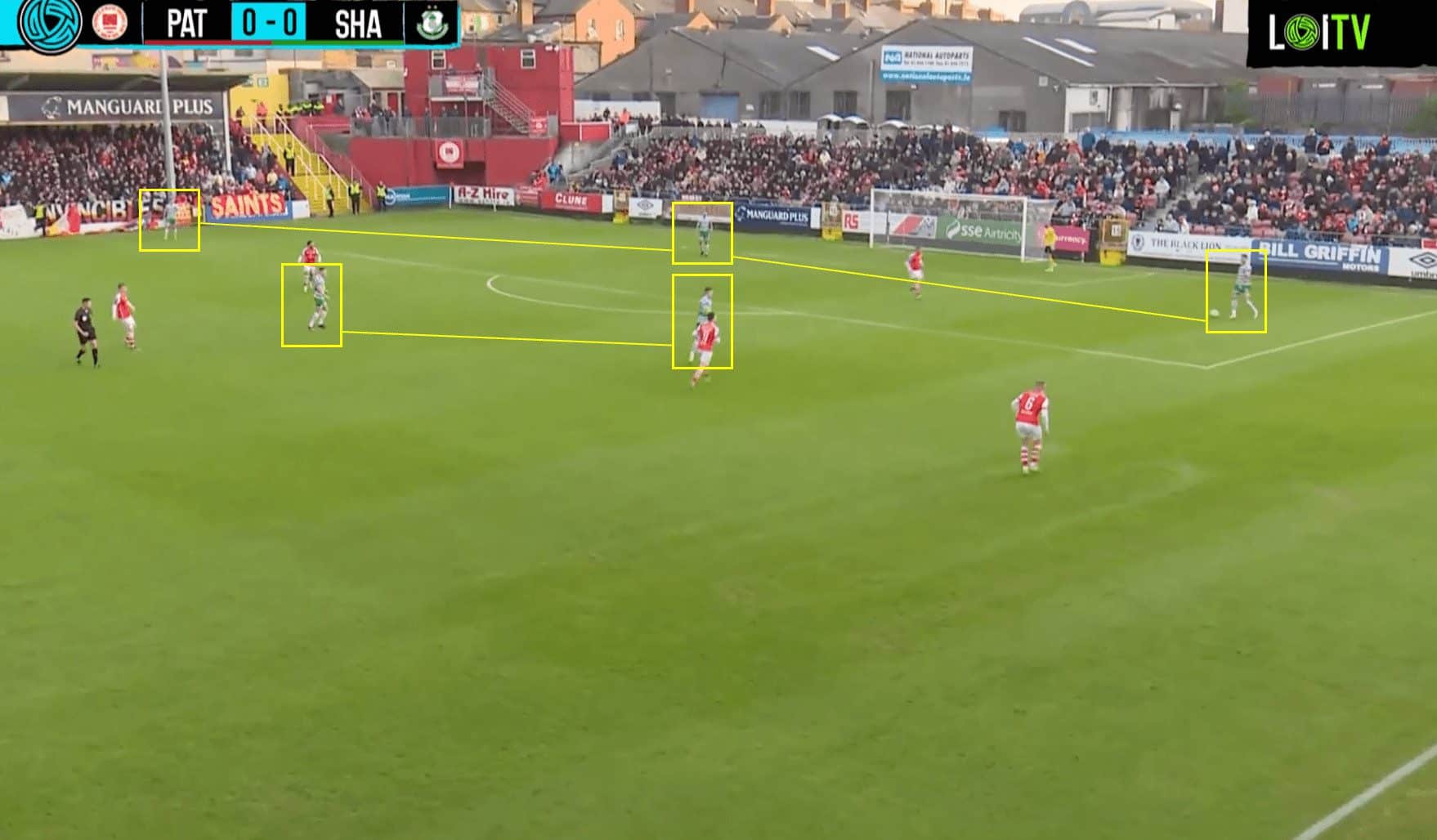
In this example, we can see the three centre-backs who move close to the goalkeeper, allowing him to play a short pass out. This invites the opposition to press them, which creates spaces further up the pitch for the South Dublin side to exploit as they move the ball swiftly to take advantage of the opposition being out of their defensive structure.
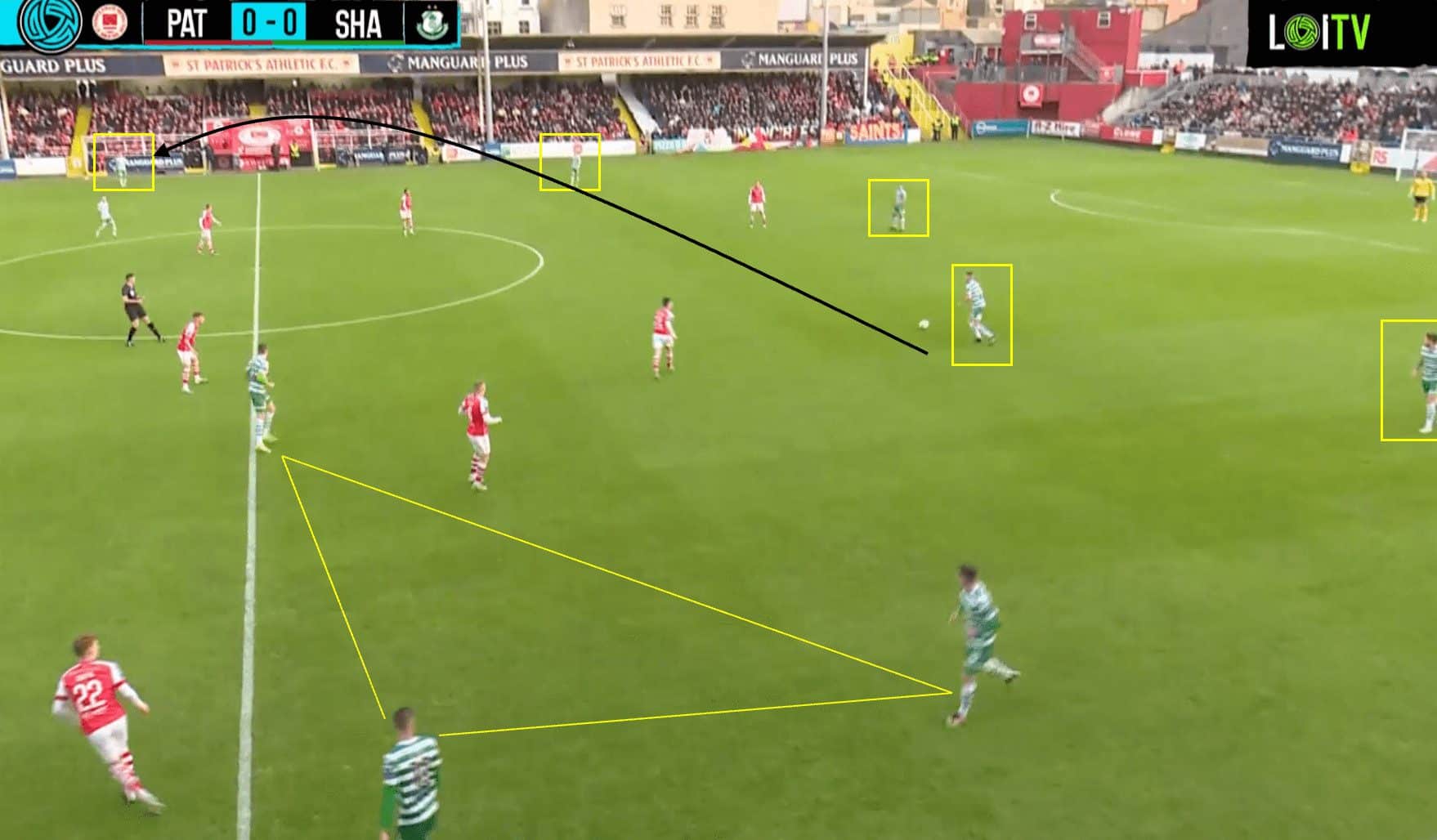
The next stage of Rovers’ build-up play involves one of the central midfielders staying with the central defenders, almost forming a back four. The left-sided central midfielder and attacking midfielder create an overload on the left side with the wing-back. This facilitates the switch to the right wing-back in space on the opposite flank. Rovers averaged 56.17 long passes per 90 during the 2023 campaign, indicating they frequently exploit their ability to switch play and hit long passes behind the opposition’s defensive line.
Wide overloads contribute to the team’s ability to switch play efficiently. By quickly transitioning the ball from one flank to the other, Rovers can catch the opposition off guard as defenders adjust to the changing dynamics of the attack. This swift ball circulation keeps the opposition on the back foot and provides opportunities to exploit spaces created by the shifting defensive structure.
Moreover, this also stretches the opposing defensive line horizontally, forcing defenders to cover a larger width of the pitch. This creates spaces in central areas for the attacking midfielders and the lone striker to exploit. As the Shamrock wing-backs advance, they not only offer additional passing options but also draw defenders out of position, opening up channels for intricate passing sequences and through balls.
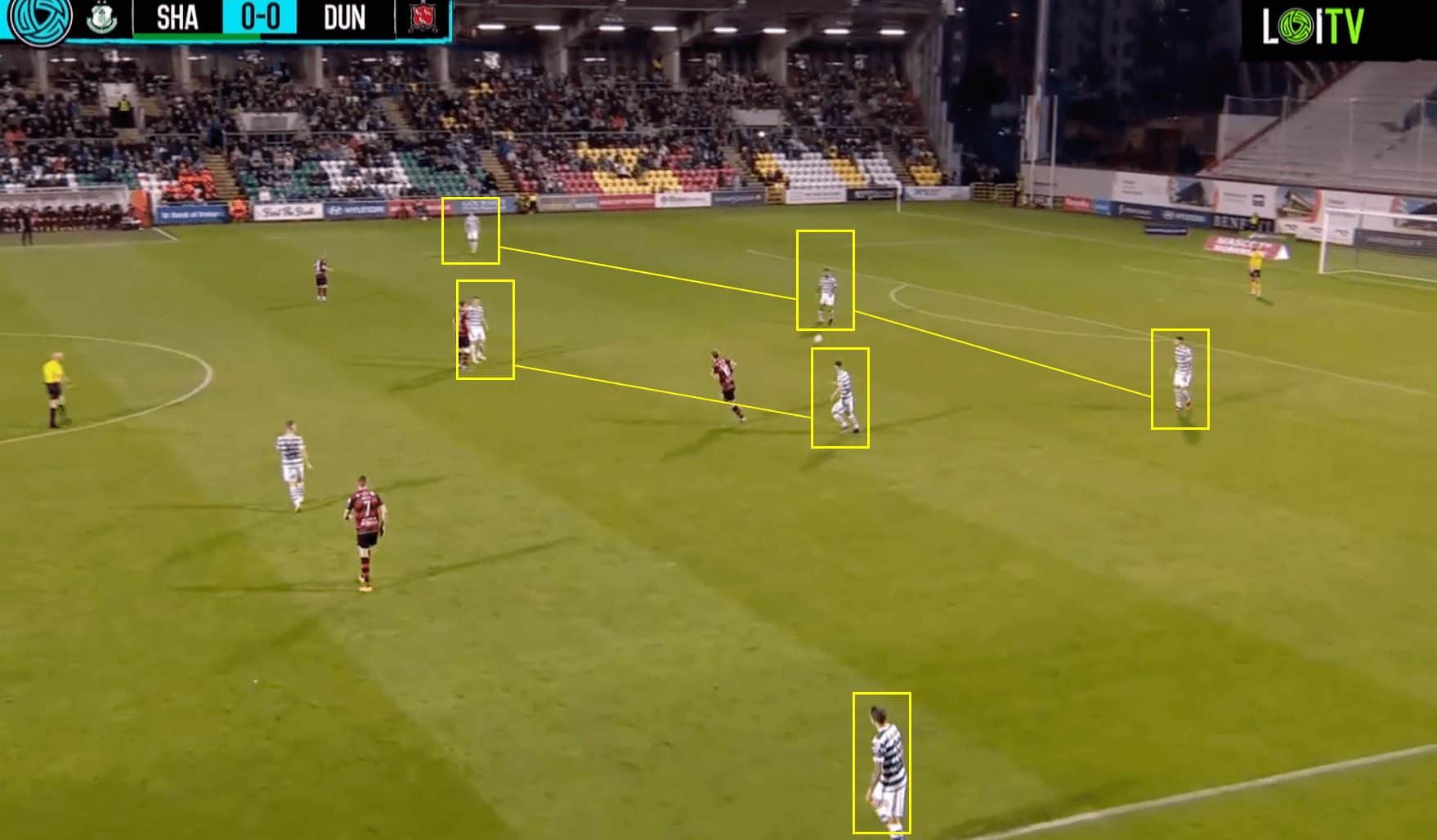
Additionally, this style of build-up play is part of Rovers’ repertoire no matter what the formation. In this particular example against Dundlak, Bradley sent his team out in a 3-5-2 system, but as we can see, the same movement occurred. The back three of Cleary, Pico Lopes and Grace are shielded by two of the midfielders. Meanwhile, Kavanagh, the left wing-back in this game, positions himself on the touchline, looking to stretch the pitch as much as possible.
Get crosses into the box
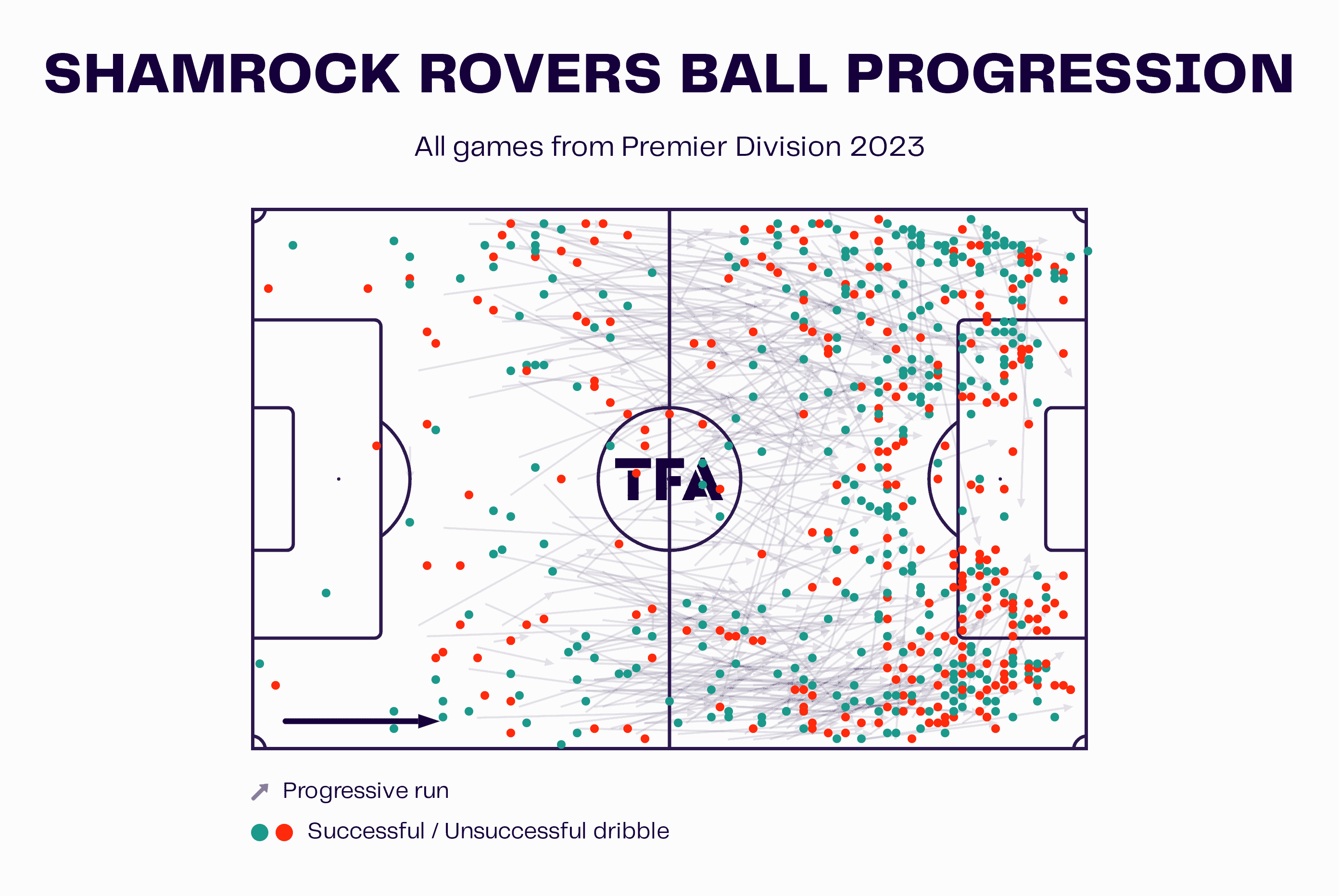

The data visuals above show us where Shamrock’s ball progression occurs. We can see that there is slightly more activity on the right side of the pitch, which ties in with what we have already seen in this tactical analysis. Rovers averaged 83.47 progressive passes per 90. Again, the majority of them were from the wide areas into the penalty area.
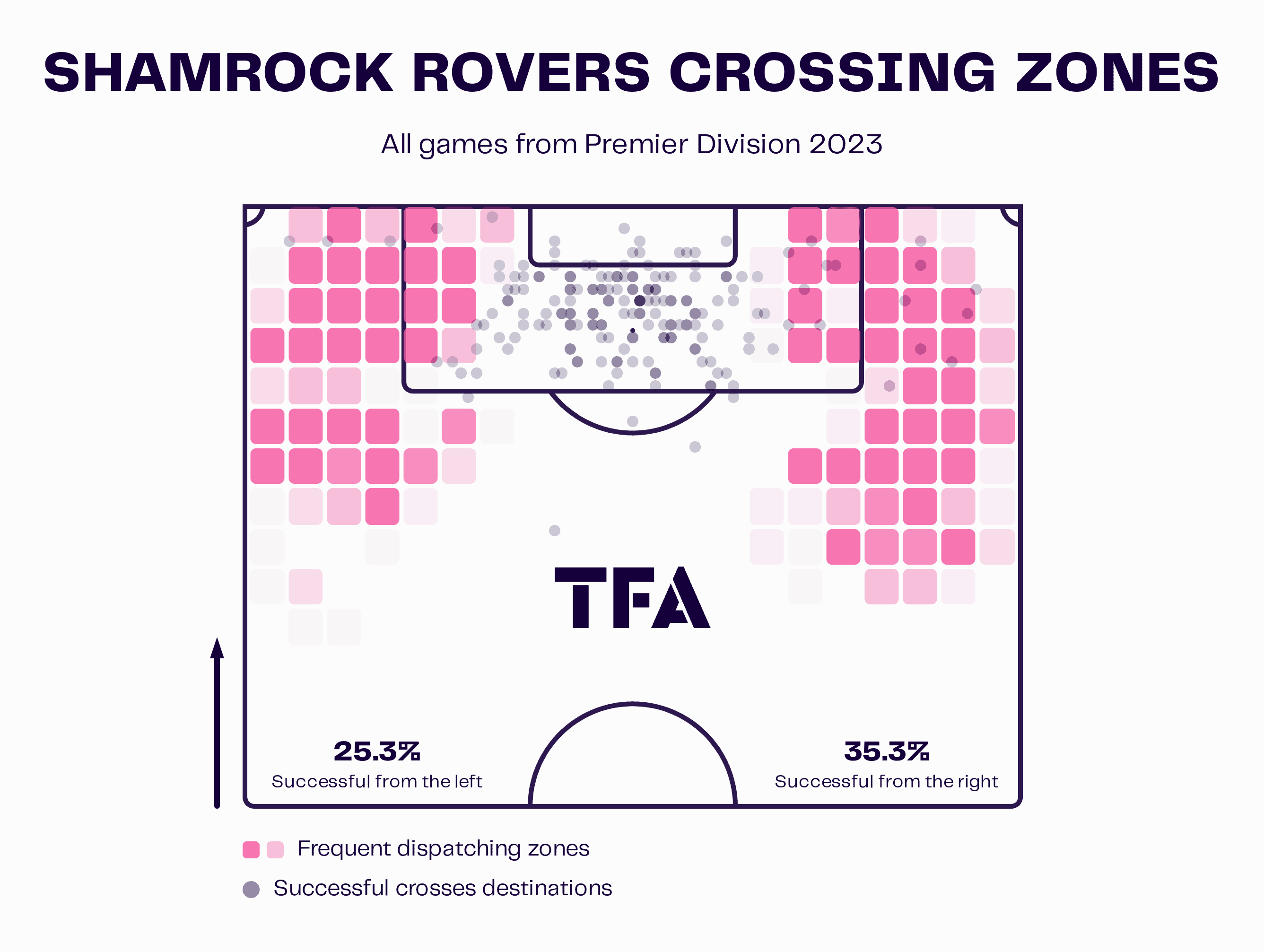
Stephen Bradley’s tactics provide an opportunity to deliver dangerous crosses into the penalty area. With the wing-backs overlapping and the wide attackers working in the half-spaces, they can all whip in accurate crosses for the lone striker or the other supporting midfielders. This poses a constant threat to the opposition, as the team can capitalise on the aerial prowess of their players in the box.
The graphic above shows us the South Dublin team’s crossing zones during the 2023 season. They averaged 18.17 crosses per 90, with the majority stemming from the right side. We can see that. As a result, more of their crosses were successful from this flank, and some of the crosses were played in from deeper areas on the right.
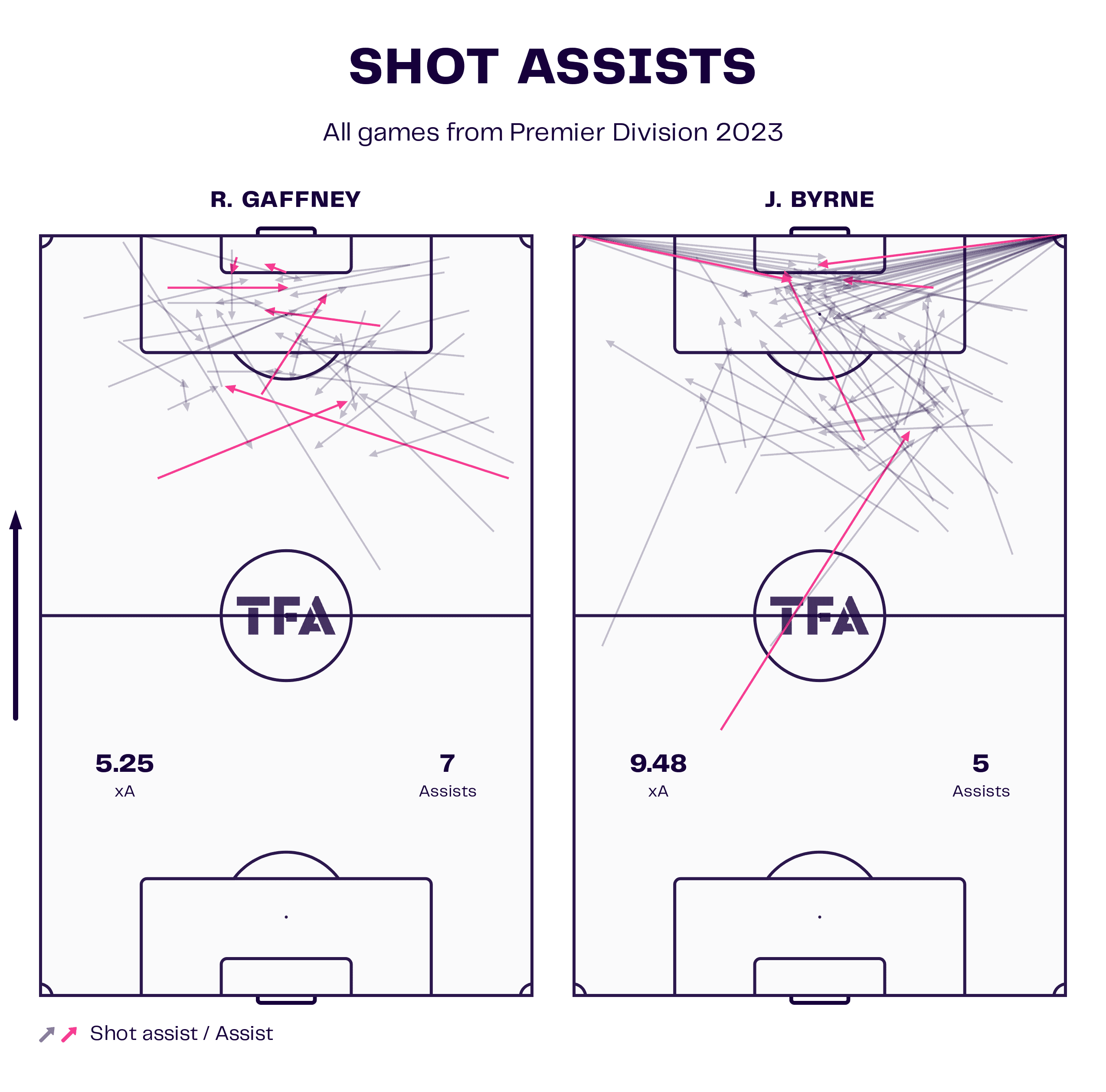
Two of Rovers’ most important players have been the two attacking midfielders in their 3-4-2-1 system. Bradley frequently rotated his starting eleven throughout the season, so no two players had the role nailed on, but two that particularly stood out were Rory Gaffney and Jack Byrne.
Byrne is a set-piece taker for the Tallaght-based outfit; therefore, we expect him to put up reasonable figures regarding assists. Although he underperforms his xA by a fair margin, this could be due to teammates failing to finish their chances.
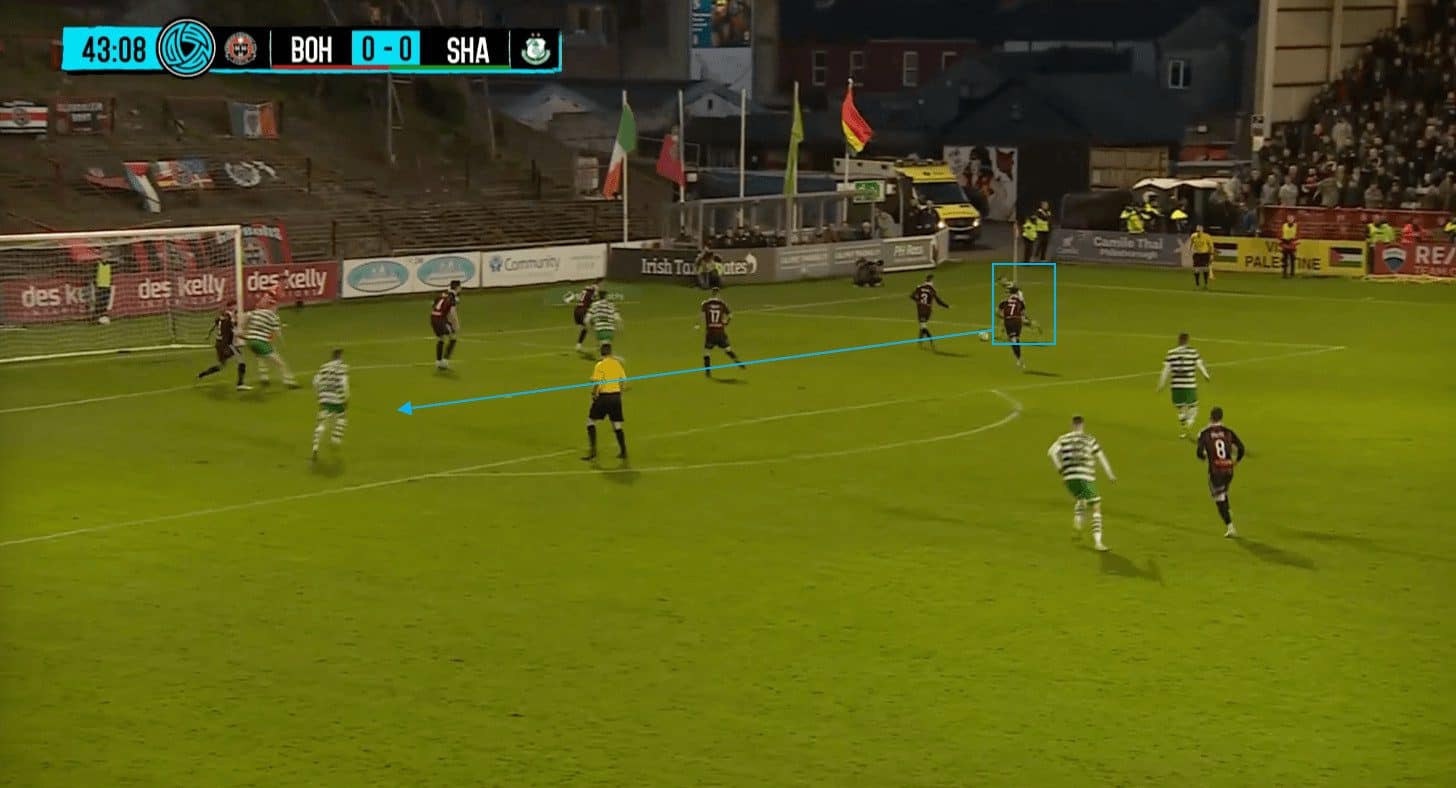
We will focus on Jack Byrne, as Gaffney will get a mention in the next section of this analysis. The former Manchester City academy player is also adept at whipping crosses into the box when he moves into the half-spaces and wide areas, averaging 3.65 per 90. A prime example can be seen above, where Byrne manages to pick out a teammate with a low cross despite having two opposition players around him.
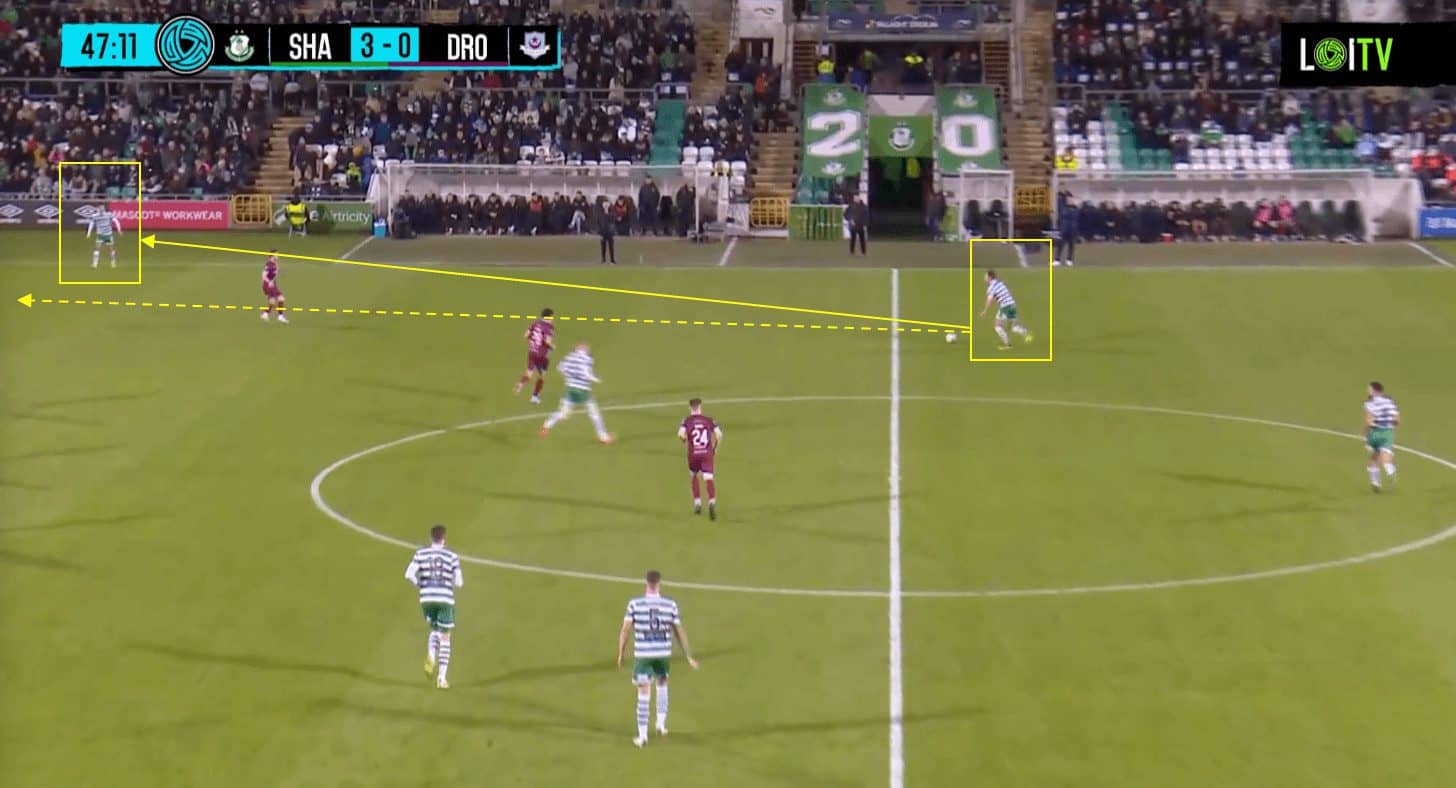
Furthermore, another way in which Stephen Bradley’s side utilises crosses into the box is via the wide centre-back’s getting forward. This is not a pivotal element to Shamrock Rovers’ tactical setup, although it does prove effective when they decide to use it.
Here, we can see Cleary, the right-sided centre-back, carry the ball out of defence. He then plays the ball into the feet of Farrugia and continues his run forward. His forward runs provide an extra passing option for the team in wide areas. He gives the team a numerical advantage during the build-up phase by pushing into half spaces and beyond. This additional passing outlet contributes to better ball circulation and helps in breaking the opposition’s defensive lines, opening up opportunities for progressive play.
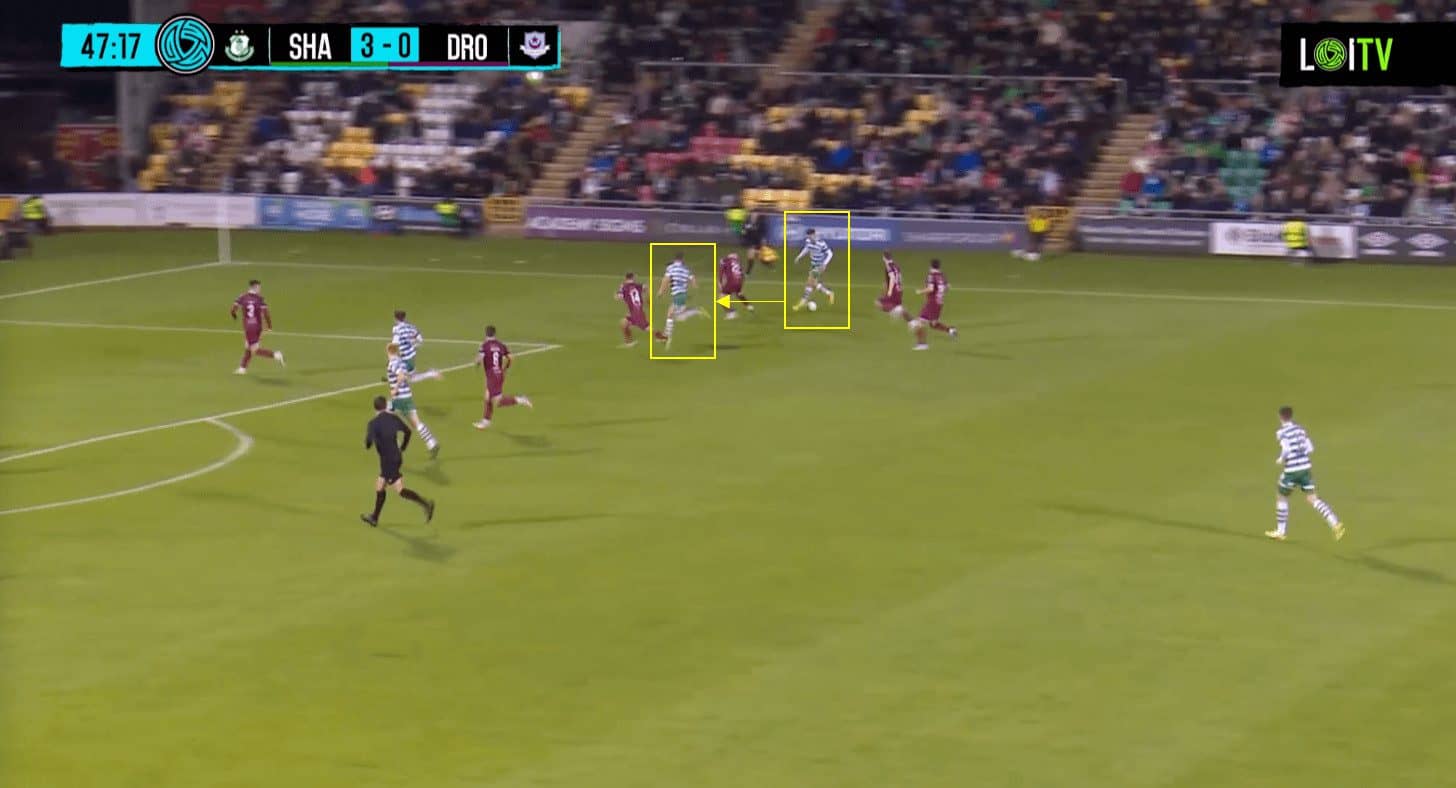
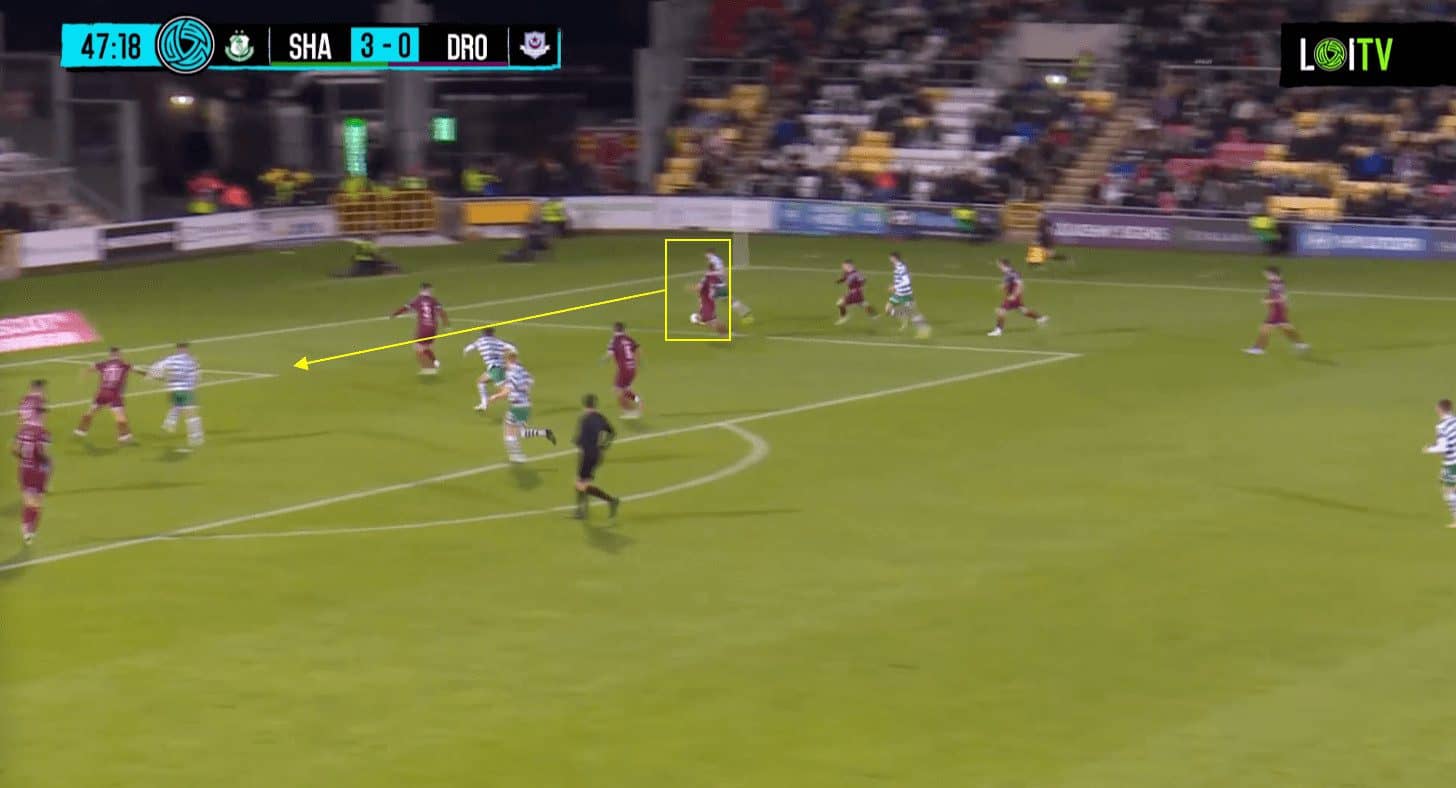
Cleary continues his run and receives a return pass from Farrugia. As a result of the centre-back’s run forward to participate in the attacking play, four opposition players have been drawn over to the right wing in an attempt to try and nullify the Rovers attack.
The ability to rely on central defenders to put crosses into the box adds unpredictability to Rovers’ attacking play. This element of surprise can catch defenders off guard and create scoring opportunities, mainly if the opposing team has focused its defensive strategies on more conventional attacking threats.
As we can see in the example above, many opposition players are drawn out of position to deal with the South Dublin club’s overloads. Consequently, spaces appear in the penalty area, making it easier for midfield runners to get on the end of any crosses. This increases the likelihood of Rovers finding the back of the net.
Quick transitions
We know that Rovers are not scared of hitting long passes forward; one way this proves to be useful is the facilitation of quick transitions from defence to attack. Launching accurate long balls from the defensive third to the attacking players primarily enables rapid progression up the pitch.
Playing it long allows the Tallaght club to bypass the crowded edge of their own penalty area and avoid the counterpress of opponents looking to force a turnover high up the pitch. This direct approach can catch the opposition off guard, as it reduces the time opponents have to organise their defensive shape. By swiftly moving the ball into advanced areas, teams can exploit any spaces left open by retreating defenders, creating immediate attacking threats.
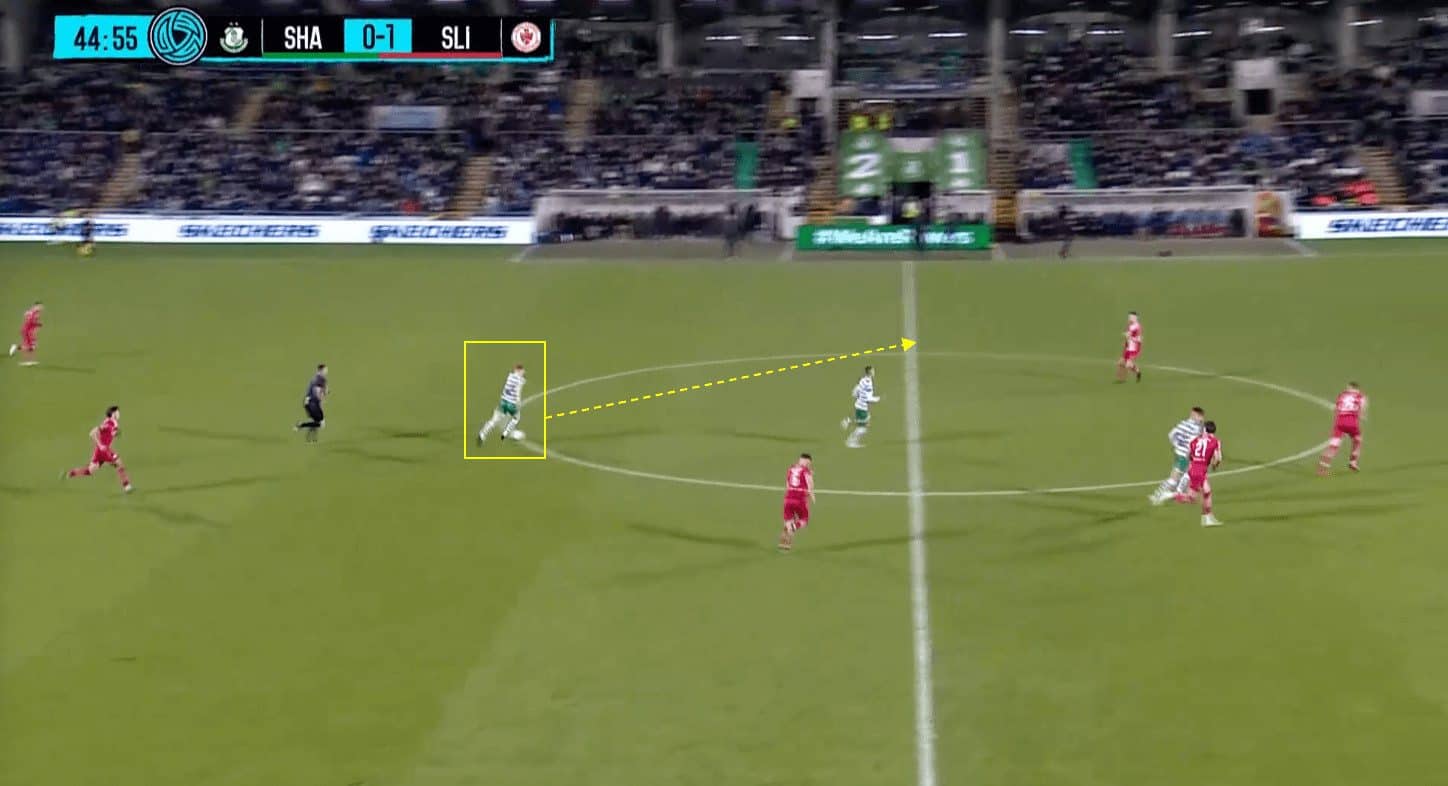
We can see in this example that a long pass has been hit up the pitch to Rory Gaffney. The attacking midfielders and forwards are responsible for driving the team and making use of these situations. He carries the ball into the space ahead, which forces the opposition backwards as they are in disarray from being caught out of position.
The speed of long-ball transitions is crucial in catching opponents during moments of defensive transition. When the opposition loses possession, a well-timed long pass can exploit the gaps left by defenders moving to regain their defensive shape, as shown above. The quick transition from defence to attack capitalises on the element of surprise, catching defenders out of position and allowing Shamrock Rovers to utilise their numerical advantages in advanced areas.
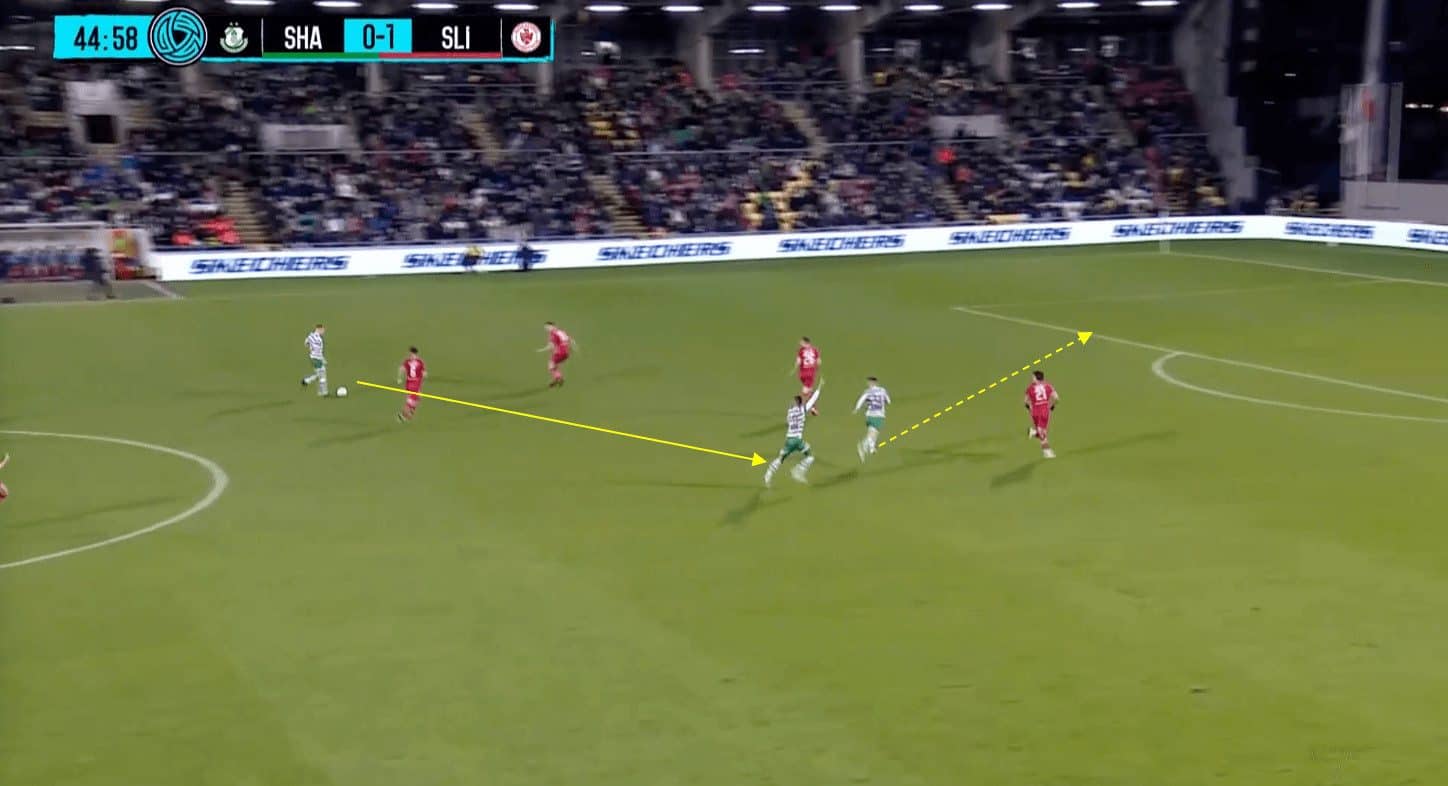

Gaffney carries the ball forward before playing an inch-perfect pass into the feet of Burke. The Shamrock Rovers number ten has space created for him as Johnny Kenny makes an intelligent off-the-ball run into the area, confusing the already struggling defenders. This allows Burke the time and space to control the ball, carry it forward and place a curling effort into the top corner.
This goal is created purely from Rovers’ ability to transition quickly from defence to attack and catch their opponents off guard.
High pressing
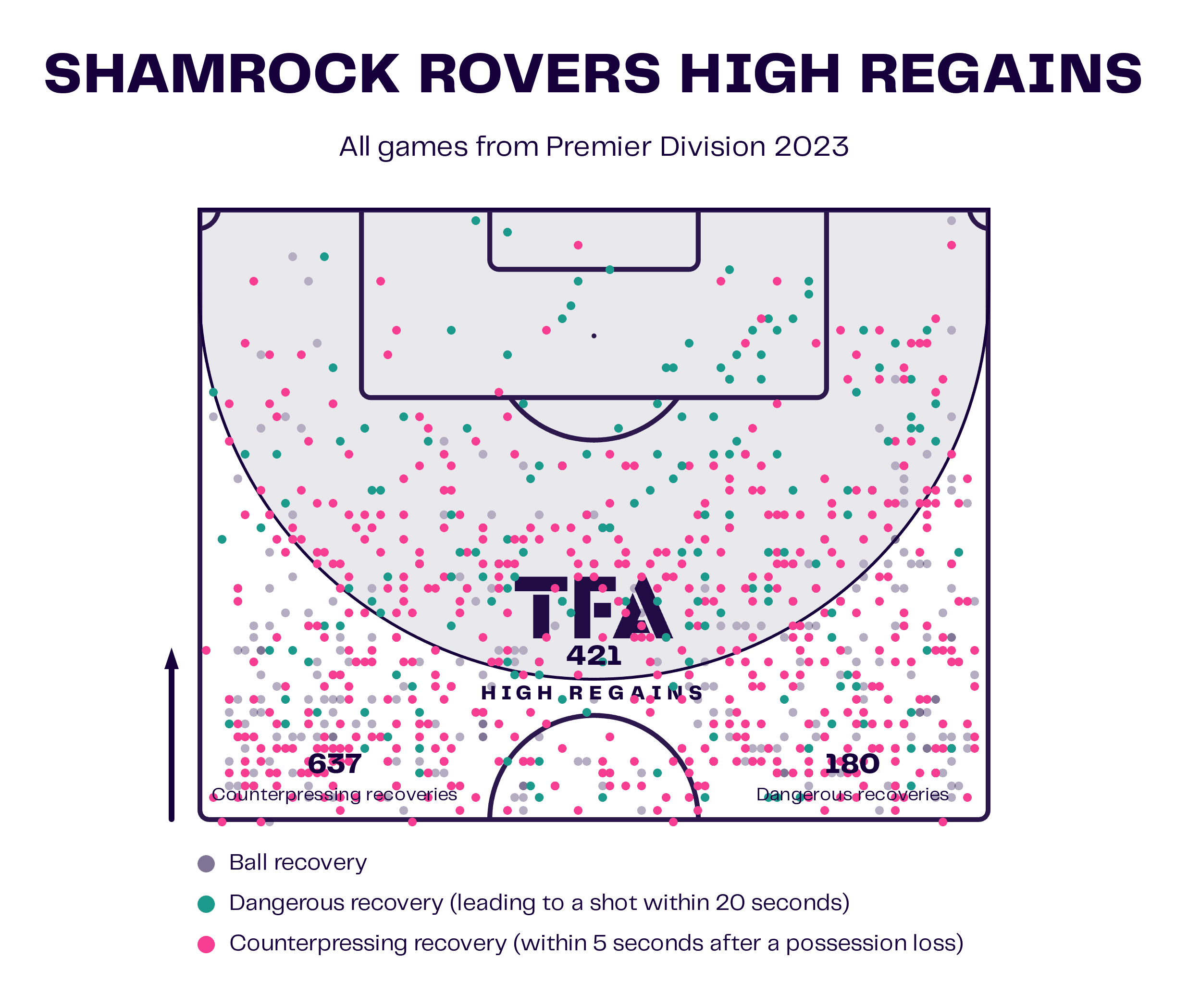
Defensively, Bradley’s tactics involve counterpressing and pressing high up the pitch to force turnovers. With a PPDA of 8.94, Rovers were one of the most high-pressing teams in the league during the 2023 campaign.
The graphic above shows that they executed 637 counterpressing recoveries during the season. 421 were classed as a high regain, meaning they recovered the ball in the attacking third. Additionally, 180 were ‘dangerous’, meaning the turnover led to a shot on goal within 20 seconds.

This is an excellent example of how Bradley expects his team to line up out of possession. We can see that St. Patrick’s Athletic are looking to build out from the back, but at least five Rovers players are ready to spring into action as soon as the goalkeeper plays a pass.
The Tallaght club aims to force mistakes, win back possession, and launch quick counterattacks by pressuring opponents close to their goal. This limits the time and space opponents have to make decisions and increases the likelihood of regaining the ball in dangerous positions, setting the stage for immediate goal-scoring opportunities.
Furthermore, as the League of Ireland Premier Division champions apply intense pressure in the opposition’s defensive third, they can force hurried and inaccurate passes. Naturally, this disrupts their opponent’s ability to establish a controlled and composed build-up.
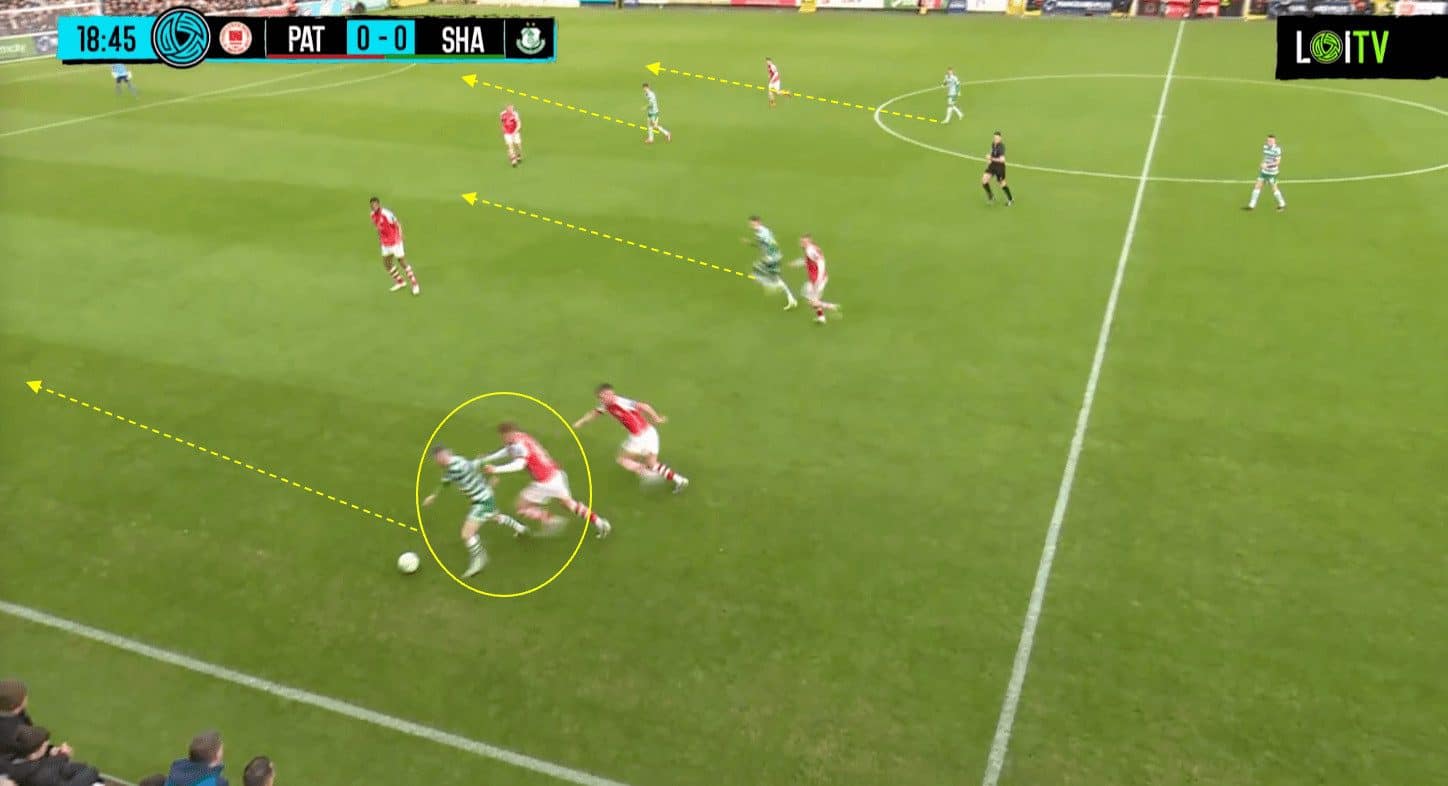
This image was taken just 12 seconds after the previous one, and we can see that Shamrock Rovers have just forced a turnover. St. Pats couldn’t play their way out of the press and have ceded possession. Additionally, plenty of runners are available for Shamrock Rovers, enabling them to quickly counterattack and make good use of the gaps that have opened up.
Stephen Bradley’s high pressing in football is a proactive defensive strategy with multiple benefits for Shamrock Rovers. It creates turnovers in advanced areas, disrupts the opponent’s passing rhythm, limits passing options, and provides the opportunity for quick and effective transitions from defence to attack.
Conclusion
Shamrock Rovers have allowed Stephen Bradley time to implement his desired style of play and are reaping the benefits. He has brought an intense pressing tactical setup that relies on players being committed and buying into his philosophies.
As a result, the club have re-established themselves at the top of Irish football. With four league titles on the bounce, stopping Rovers in their current form will be challenging. Stephen Bradley has proven himself to be one of Ireland’s best managers at the moment, bringing plenty of success back to Tallaght.





Comments